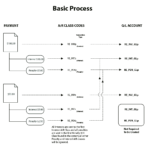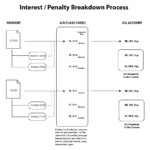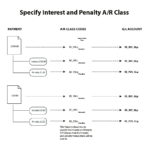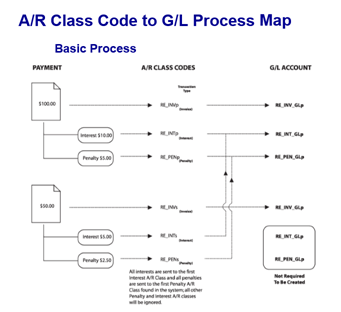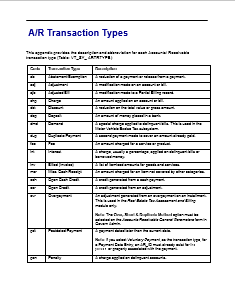Accounts Receivable (A/R) Refund Reversal
Overview
The section describes the Refund Reversal transaction process. This is available for posted refunds only. It can be run if a payment reversal was created in error.
The Refund Reversal form is accessed from a Posted Refund in the Govern A/R Inquiry form. Therefore, before a refund reversal can be created, the following processes must take place:
- An invoice must be created for the A/R record.
- The invoice must be Billed and posted.
- The bill must be paid and the payment must be posted.
- The payment must be refunded and the refund must be posted.
NOTE: Security options are pending development.
Documentation
101-ar-frm-028 Refund Reversal
Accessing the Refund Reversal Form
Read More... To access the Refund Reversal form: General Information Detail The following fields can be modified: The Receipt Number is automatically generated according to the setup in the Cash Collection Parameters. It comprises a three-digit code that is based on either the Receipt Group or the user ID of the logged-in user. The code is followed by the receipt sequence. This is an eight-digit number that starts with one for each user or receipt group. The number increases by one for each new receipt. Subsystem Year Bill Number Invoice No. Check No. The Check Number is displayed with the record in the A/R Inquiry form under Balance Forward Details. If the check number is created by the Refunds form in Govern, it is displayed when the transaction is saved. Cycle Code It is now mandatory to create A/R Cycle Codes for Real Property and Personal Property tax billing. This is used for tax billing cycles and is linked to the A/R Class Code in GNA. You need to set up at least one Cycle Code, but you can create multiple codes. For example, you could have one cycle for municipal tax and a second for school tax. Frozen IDs are now created for cycle billing. A new Frozen ID is assigned when you run the Posting to A/R batch process. This is called a Certified Record. It is displayed in the Govern History Panel with the Cycle Code. The first Certified Record is assigned Frozen ID -1, the second -2, the third is assigned -3, and so on if there are multiple cycle codes. A new Tax Audit record is created for all the parcels included in the batch process. The Entry Code for these records is set to Original. The Frozen ID is updated and a new entry is listed in the History Panel. For further details, refer to the Govern Real Property Tax documentation. Date Effective On Amount Interest Total to Refund Class Code From Installment Number Due Date Discount Date Justification Code Deposit Number Automatically generated deposit numbers are composed of one or two of the following fields: date, last deposit, and user ID. This number can be modified if you have the required security permissions. If Deposit Management is activated, a drop-down list is added to the Deposit Information parameter. This is populated by the deposit numbers created in the Deposit Management form. See Deposit Management on page 203. Do one of the following: Notes By default, the Payer information fields display the name of the taxpayer and a code that identifies the type of letter to be issued with the bill. To modify the payer information: The record is displayed on the A/R Inquiry form when the transaction is complete. The Amount and Payer Name fields under Cash Flow display further details when you hover the mouse over a specific transaction: Accounts Receivable (A/R) Inquiry Accounts Receivable (AR) – What’s New 101-ar-frm-028
Details of the record are displayed in the Details section.
A context-sensitive menu appears.
The Refund Reversal form appears.
The following fields are populated with data from the selected refund.
General Information
Receipt Number
The subsystem for the record or entry selected on the A/R Inquiry form is displayed.
This field displays the fiscal year of the transaction.
This field displays the bill number for the selected record.
Enter an invoice number for the transaction.
Enter a check number in this field, if applicable.
This field displays the Cycle Code associated with the record (Table: VT_USR_ ARCYCLE).
This field displays the entry date for the refund. By default, this is the current date. To change the date, click the calendar beside this field and select a new date.
This field displays the date that the transaction becomes effective. To enter a date, click the calendar beside the field and select a new date.
This field displays the amount of the refund. It cannot be modified.
This field displays interest accumulated on the amount. It cannot be modified.
this field displays the total amount to refund. It cannot be modified.
This field is automatically populated with the A/R Class Code for the selected refund. The drop-down list contains all the A/R Class Codes that are defined with the Refund Transaction Type or with no specific transaction type. Select a different A/R Class Code from the drop-down list (Table: VT_ USR_AR_CLASS).
Select the installment period for the refund: first, second, third, fourth installment or total (Table: VT_SY_ INSTALL).
Click the calendar icon beside the Due Date field and select the date the refund is due, if applicable.
Click the calendar icon beside the Discount Date field and select the final date for a discount on the refund.Comment
Select a Justification Code to explain the reason for the refund (Table: VT_USR_ARREASON).
Depending on the options selected in GNA, deposit numbers can be automatically generated or user-defined.
Enter any notes or comments applicable to the refund.Payer Information
By Name ID
By Tax Payer Account Number
By Name
By Phone Number
From NA_ExternalA/R Inquiry for Refund
Related Topics


